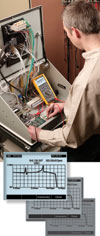

The new Fluke 287 true-rms handheld multimeter has multiple features specifically designed for electronic technicians working in service applications, as well as those involved in the design and development of new electronic products.
The instrument boasts a 1/4 VGA dot-matrix display to offer flexibility in changing function displays and to provide more information at a glance. In MIN MAX mode it is large enough to show the current reading, the Min, Max and Avg readings along with their time stamps, elapsed time, and the start time and date for the recording session, simultaneously. This capability can be very useful in quickly tracking down interactions between sensitive electronics.
As an illustration of the added capability this display brings to recording and logging, Fluke offers the example of how one creative engineer tested the design of a new power inverter using a logging meter. He needed to record the DC input voltage and current, the output AC voltage and current, and the temperature rise inside the inverter, while the input voltage and load were varied. The solution was to use five logging meters, download the results to FlukeView Forms software and graph them together in a single report.
In this example, the user required the ability to see his results at the end of each test segment, without having to download to a computer each time. To support this, the 287 offers a feature called TrendCapture, a logging and graphing feature that was developed with these needs in mind. TrendCapture appears as a strip chart-like display onscreen, with date and time information and a digital readout for whichever point on the graph is selected with the cursor. The meter can also save multiple recording sessions before downloading, and it can record for over a week without a battery change.
Finally, the screen has enough room to display how-to information about the meter’s functions, which is performed by selecting the function and pressing the (i) info button.
Other features include a 100 kHz bandwidth, V a.c. and mV a.c. functions, and the ability to read voltage values expressed as dBV or dBm. This true-rms reading function is useful for evaluating the performance of servo loops and audio amplifiers. Since one of the uses for dB measurements is testing the frequency response of amplifiers, the DMM includes the ability to simultaneously measure dBV or dBm and the frequency of the measurement in dual display mode. Add to this the ability to setup the dBm mode for a broad range of reference impedances and the 287 becomes well suited for amplifier and audio transmission line performance testing.
Among the instrument’s features is capacitance that reads up to 100 mF, useful for measuring supercapacitors and the large capacitors used in electronic motor drives and power inverters.
AC + DC true-rms voltage and current readings can be made showing individual AC and DC values in a dual display, or the two values may be combined to display the true-rms signal present. The dual display mode is useful for evaluating DC power supplies and ripple voltage. This mode also supports troubleshooting triac-based power controllers where both AC and DC values are present. AC+DC true-rms allows evaluation of the heating effect of the combined values. Users can also revert to a standard DC measurement to evaluate duty cycle and pulse widths of these complex waveforms in dual display mode.
The mV d.c. menu offers the ability to convert the meter to a thermometer in either degrees Fahrenheit or Celsius, based on the output of a K-type thermocouple. In this mode, the meter monitors the temperature of the input jacks to provide the reference value needed for accurate measurement. And, using the recording function to log temperature over time means the test technician can evaluate electronic system cooling over a wide range of conditions for a day or more.
The 287 has a 50 000 count resolution and can read down to 1 V on its 50 mV range. Basic DC accuracy is 0,025%, while basic true-rms AC readings are accurate to 0,3%.
For more information contact Comtest, +27 (0)11 608 8520, [email protected], www.comtest.co.za
| Tel: | +27 10 595 1821 |
| Email: | [email protected] |
| www: | www.comtest.co.za |
| Articles: | More information and articles about Comtest |

© Technews Publishing (Pty) Ltd | All Rights Reserved